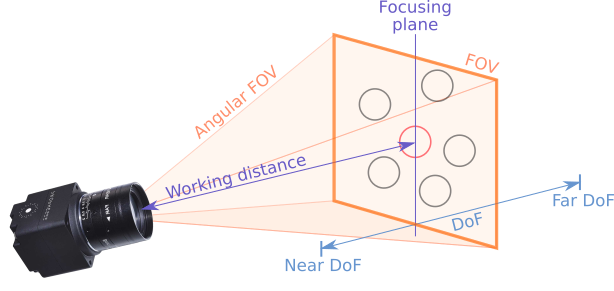Optics calculator
Optics calculator helps you to understand what can be seen by your system featuring a sensor and optics. It takes as input parameters the sensor and the optics characteristics, the working distance and an object/particle size, and provides estimates for the Field of View (FOV) of the system, Spatial resolution, Magnification, and Depth of Field (DoF).
Note
The calculator is based on theory only. Among the lens characteristics, it considers only the focal length and the aperture without taking into account any other characteristic like distortion, etc. Therefore, the computed values should be seen as a rough approximation. This approximation becomes inaccurate when the lens focal length is shorter than the sensor size.
The calculator estimates the following measures:
Angular Field of View (FOV) - an angle of view that is seen by the system,
FOV at the working distance - an area that is seen the system at the given working distance,
Spatial resolution - a measure of the smallest object that can be resolved by the sensor (seen by a single pixel),
Optical magnification - a ratio of the perceived object’s size (the size of the object onto the sensor plane) to the real size of the object,
Perceived object/particle size - the size of the object/particle perceived by the system (as a number of pixels per object/particle) that can be used to qualify if the object is seen good enough for a particular application,
Depth of Field (DoF) - a range of distances within which the object can be perceived acceptably sharp without refocusing (assuming that the lens is focused at the working distance),
DoF far limit - the distance between the camera and the furthest object that can be perceived acceptably sharp,
DoF near limit - the distance between the camera and the closest object that can be perceived acceptably sharp,
Hyperfocal distance - the closest distance at which a lens can be focused while keeping objects at infinity acceptably sharp.

These measures give you an idea on what can be seen with your system and how well. Furthermore, it helps to choose a lens with the right FOV for your application and do a right setup.
If the resulted FOV and/or resolution are not enough for your application, then you could change the optics (on most of Prophesee EVKs) to a more suitable optics. See more details on optics choice on Knowledge Center.